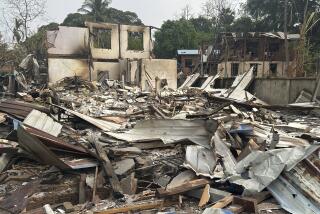UPDATE / THE CAMBODIA WAR : Rebels’ Gains on Battlefield Overshadow 5-Nation Talks
- Share via
BANGKOK, Thailand — The increasingly unstable situation in Cambodia appears to be offering fresh proof of the old soldier’s maxim that a government cannot achieve at the negotiating table what it fails to win on the battlefield.
A new round of talks is scheduled to open Monday in Paris involving officials from the five permanent members of the U.N. Security Council. The five--Britain, France, China, the Soviet Union and the United States--are trying to reach a consensus on the best way to achieve a cease-fire in the 11-year-old Cambodian civil war and to hold U.N.-supervised elections.
Rebel Victories
But the talks are increasingly overshadowed by the recent battlefield gains by the Khmer Rouge, the hard-line Communist guerrilla group that ruled Cambodia from 1975 until early 1979 and has been blamed for causing more than 1 million deaths through brutality and starvation.
With an army estimated at 35,000 hardened and motivated fighters, the Khmer Rouge is the strongest branch in a loose, three-party resistance coalition fighting the Vietnamese-backed Phnom Penh government from bases in neighboring Thailand.
Last month, the Khmer Rouge announced a series of military victories, including the brief but psychologically important occupation of Kompong Thom, a provincial capital just 80 miles north of Phnom Penh.
Refugees’ Flight
With the fighting, about 20,000 refugees have streamed into provincial towns in recent days, provoking memories of the similar exodus from the provinces in 1975 that preceded the Khmer Rouge’s defeat of the U.S.-backed regime in Phnom Penh.
This time, however, relief workers believe that the Phnom Penh government may be deliberately encouraging the refugees to leave their homes in order to deny the Khmer Rouge a base of support in rural areas.
“There has been a fair amount of fighting around Phnom Penh,” said one Western diplomat. “The pace of fighting has definitely picked up momentum in the last month.”
Winds of Diplomacy
At least two factors have helped accelerate the resistance offensive, according to military analysts.
The first was the start of the annual monsoon last month, generally a time when guerrilla forces in the region take the initiative because the government’s more mechanized units are unable to maneuver effectively in the rain-soaked countryside.
This year, the Khmer Rouge offensive also appeared timed to inflict maximum damage to coincide with talks in Tokyo between Prince Norodom Sihanouk, the nominal leader of the fractious resistance coalition, and Premier Hun Sen of the Phnom Penh government.
At the end of their talks, Sihanouk and Hun Sen signed an accord calling for military restraint as a prelude to the creation of a Supreme National Council that would run the country until elections are held.
Power-Sharing
Under the plan, the Supreme Council would be composed of six representatives from Phnom Penh and six from the resistance. But the Khmer Rouge rejected the Tokyo talks, which had been arranged by Japan, Thailand and the United States, because the formula appeared to give equal standing to the Phnom Penh government and the resistance.
The Khmer Rouge reiterated its demands, which are unacceptable to Cambodia and Vietnam, that the Phnom Penh regime hand over power to a four-party coalition government, giving equal authority to each of the four factions.
More to Read
Sign up for Essential California
The most important California stories and recommendations in your inbox every morning.
You may occasionally receive promotional content from the Los Angeles Times.













